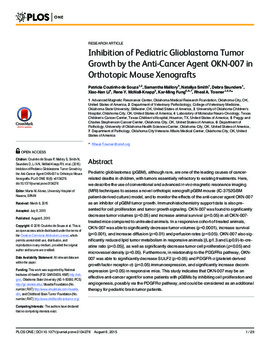| dc.contributor.author | Patricia Coutinho de Souza | |
| dc.contributor.author | Samantha Mallory | |
| dc.contributor.author | Nataliya Smith | |
| dc.contributor.author | Debra Saunders | |
| dc.contributor.author | Xiao-Nan Li | |
| dc.contributor.author | Rene Y. McNall-Knapp | |
| dc.contributor.author | Kar-Ming Fung | |
| dc.contributor.author | Rheal A. Towner | |
| dc.date.accessioned | 2017-03-05T22:55:04Z | |
| dc.date.available | 2017-03-05T22:55:04Z | |
| dc.date.issued | 2015-08-06 | |
| dc.identifier.citation | Coutinho de Souza P, Mallory S, Smith N, Saunders D, Li X-N, McNall-Knapp RY, et al. (2015) Inhibition of Pediatric Glioblastoma Tumor Growth by the Anti-Cancer Agent OKN-007 in Orthotopic Mouse Xenografts. PLoS ONE 10(8): e0134276. doi:10.1371/journal.pone.0134276 | en_US |
| dc.identifier.uri | https://hdl.handle.net/11244/49266 | |
| dc.description | We thank the Peggy and Charles Stephenson Cancer Center at the University of Oklahoma, Oklahoma City, OK, for funding, who received an Institutional Development Award (IDeA) from the National Institute of General Medical Sciences of the National Institutes of Health under grant number P20 GM103639 for the use of the Histology and Immunohistochemistry Core for providing immunohistochemistry and photographic services. This work was also supported by Oklahoma State University, Center of Veterinary Health Science (Support Grant AE-1-50060 to P.C.S.), the Musella Foundation (R.A.T.), and the Childhood Brain Tumor Foundation (R.A.T.). | en_US |
| dc.description | | en_US |
| dc.description.abstract | Pediatric glioblastomas (pGBM), although rare, are one of the leading causes of cancer-related deaths in children, with tumors essentially refractory to existing treatments. Here, we describe the use of conventional and advanced in vivo magnetic resonance imaging (MRI) techniques to assess a novel orthotopic xenograft pGBM mouse (IC-3752GBM patient-derived culture) model, and to monitor the effects of the anti-cancer agent OKN-007 as an inhibitor of pGBM tumor growth. Immunohistochemistry support data is also presented for cell proliferation and tumor growth signaling. OKN-007 was found to significantly decrease tumor volumes (p<0.05) and increase animal survival (p<0.05) in all OKN-007-treated mice compared to untreated animals. In a responsive cohort of treated animals, OKN-007 was able to significantly decrease tumor volumes (p<0.0001), increase survival (p<0.001), and increase diffusion (p<0.01) and perfusion rates (p<0.05). OKN-007 also significantly reduced lipid tumor metabolism in responsive animals (Lip1.3 and Lip0.9)-to-creatine ratio (p<0.05), as well as significantly decrease tumor cell proliferation (p<0.05) and microvessel density (p<0.05). Furthermore, in relationship to the PDGFRα pathway, OKN-007 was able to significantly decrease SULF2 (p<0.05) and PDGFR-α (platelet-derived growth factor receptor-α) (p<0.05) immunoexpression, and significantly increase decorin expression (p<0.05) in responsive mice. This study indicates that OKN-007 may be an effective anti-cancer agent for some patients with pGBMs by inhibiting cell proliferation and angiogenesis, possibly via the PDGFRα pathway, and could be considered as an additional therapy for pediatric brain tumor patients. | en_US |
| dc.language.iso | en_US | en_US |
| dc.publisher | PLos One | |
| dc.relation.ispartofseries | PLoS ONE 10(8): e0134276 | |
| dc.relation.uri | http://www.plosone.org/article/info%3Adoi%2F10.1371%2Fjournal.pone.0134276 | |
| dc.rights | Attribution 3.0 United States | |
| dc.rights.uri | https://creativecommons.org/licenses/by/3.0/us/ | |
| dc.subject | Cancer treatment,Pediatrics,Glioma,Mouse models,Magnetic resonance imaging,Magnetic resonance spectroscopy,Glioblastoma multiforme,Cell proliferation | en_US |
| dc.title | Inhibition of Pediatric Glioblastoma Tumor Growth by the Anti-Cancer Agent OKN-007 in Orthotopic Mouse Xenografts | en_US |
| dc.type | Research Article | en_US |
| dc.description.peerreview | Yes | en_US |
| dc.description.peerreviewnotes | http://www.plosone.org/static/editorial#peer | en_US |
| dc.identifier.doi | 10.1371/journal.pone.0134276 | en_US |
| dc.rights.requestable | false | en_US |

